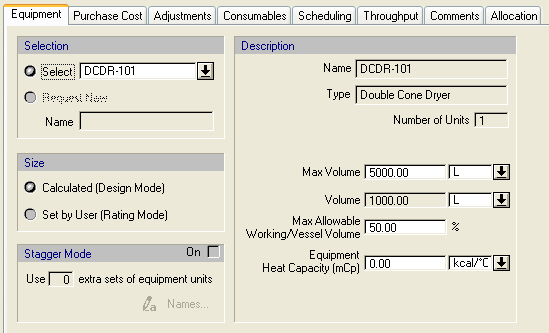

The following table shows the meaning of the variables appearing in this tab, as well as their default values and their generally acceptable range. Note that due to the manner by which the variables are used by the sizing and costing equations, the range of acceptable values may be further reduced.
|
Variable |
Default Value |
Range |
|
|
||
|
◙ Volume |
1000.0 L |
Positive |
|
◙ Max Volume |
5000.0 L |
Positive |
|
○ Max Allowable Working/Vessel Volume |
50% |
(0,100] |
|
○ Equipment Heat Capacity |
0 kcal/°C |
Positive. |
Symbol Key: ○ User-specified value (always input); ● Calculated value (always output); ◙ Sometimes input, sometimes output
The equipment is sized based on its volume. In Design Mode, the user specifies the maximum equipment volume and the maximum allowable working to vessel volume. The working volume depends on the type uses of the vessel (see below for a list all uses). This is divided by the operation’s working to vessel volume ratio to convert it into vessel volume demand. If the vessel volume demand exceeds the maximum volume per unit, the system assumes multiple identical units operating in parallel with a total volume equal to the vessel volume demand.The equipment’s max allowable working to vessel volume ratio acts as constraints on the operation’s working to vessel volume ratio (i.e., the operation’s working to vessel volume ratio must not exceed the equipment’s max working to vessel volume ratio).
In Rating Mode, the user specifies the number of parallel units, their volume, and the maximum allowable working to vessel volume ratio. The program also calculates exactly as in the design mode case the demand on vessel volume by the operation carried out as part of the unit procedure(s) hosted by the equipment resource, and if the operation’s vessel volume demand of exceeds the actual vessel volume, it generates a warning.
The equipment purchase cost is estimated using built-in correlations derived from vendor data. The equipment cost is a function of the volume.
● Equipment Heat Capacity; the product of equipment mass times its specific heat capacity. It is used by operations that are executed in the vessel and involve heating and/or cooling. If part of the heat exchange is directed to the vessel, then this variable is used to estimate heating/cooling losses.
For more information on this equipment, see
● Hopper
For information on the left-hand side variables and options, see Equipment Data Dialog: Equipment tab.